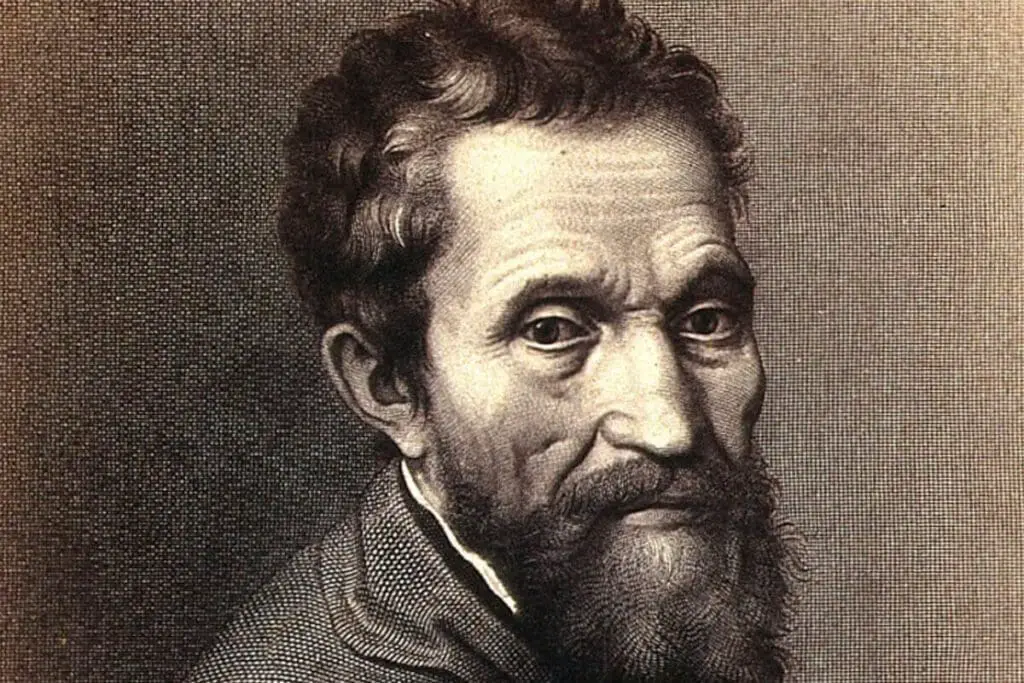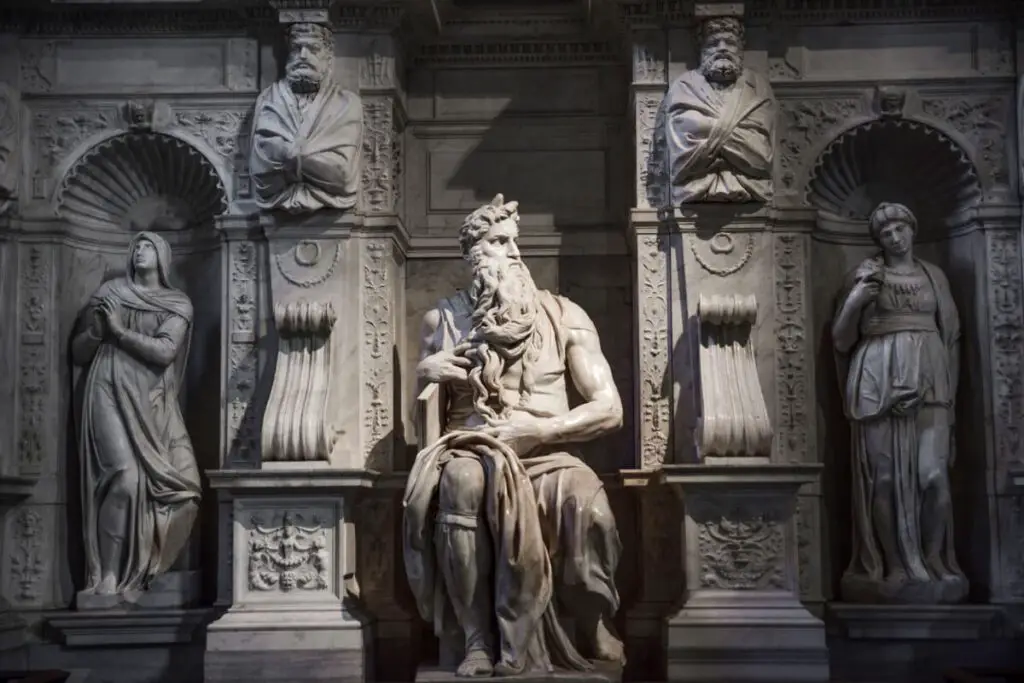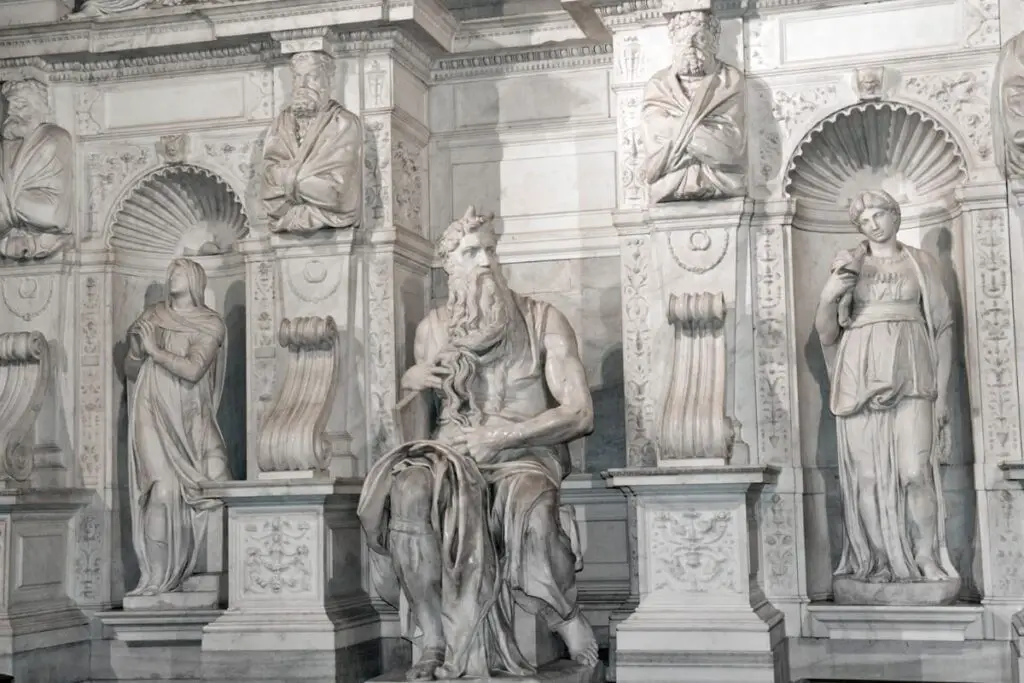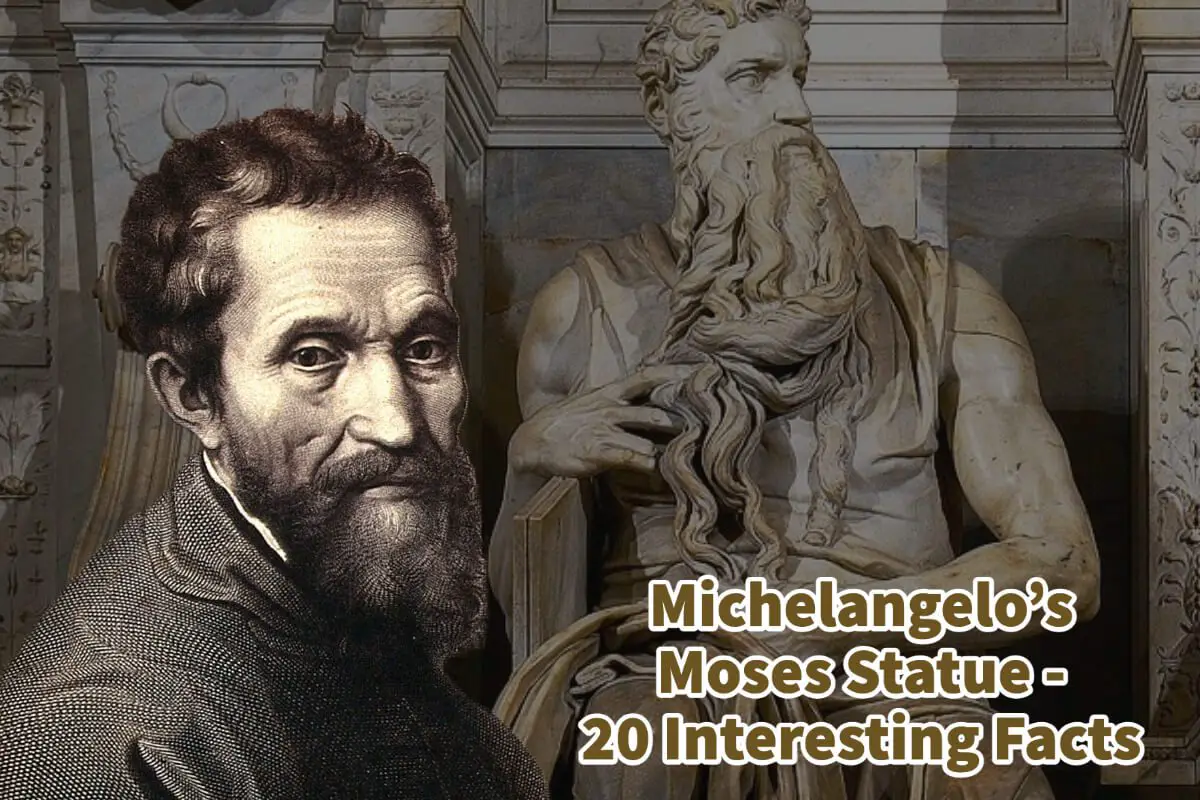As a form of human expression, sculpture often transcends language, culture, and time. Few works exemplify this truth better than Michelangelo’s Moses, a masterpiece carved from a single block of marble.
One of the most essential statues that Michelangelo created is the Moses statue for Pope Julius II’s tomb. The statue shows Michelangelo’s artistic genius and ability to carve such an intricate work of art out of one piece of marble. Read on as we explore twenty exciting facts about Michelangelo’s Moses statue.
Table of Contents
- 20 Interesting Facts About Michelangelo’s Moses Statue
- The Home Of Michelangelo’s Moses Statue
- The Grand Tomb Project And Michelangelo’s Moses Statue
- Michelangelo’s Masterpiece Of Moses
- The Moses Statue Symbolizes Patience
- The Mysterious Horns And The Moses Statue
- Michelangelo’s Hidden Self-Portrait
- Moses StatueVein Detail
- The Moses Statue Is Testament To Renaissance
- The Moses Statue And Ten Commandments Tablets
- The Moses Statues Is The Overlooked Giant
- Michelangelo And Incomplete Works
- Moses’ Robes Explored
- The Moses Statue Is A Testament To Michelangelo’s Artistic Skill
- The Moses Statue Is The Unintentional Star
- The Renaissance Competition Between Michelangelo And Raphael
- The Impact On Art History And The Moses Statue
- The Model Of Moses Statue
- The Moses Statue And The Prophetic Representation
- The Orientation Of The Moses Statue
- The Cultural Significance Of The Moses Statue
- Frequently Asked Questions
- Related Questions
20 Interesting Facts About Michelangelo’s Moses Statue
When most people think about Michelangelo, we tend to think about the Statue of David or the Sistine Chapel Ceiling. Most people do not think about Michelangelo’s Moses Statue, yet the Moses Statue is a significant statue that Michelangelo produced.

The Moses Statue depicts the Biblical prophet Moses, who embodies the artist’s prowess and a rich tapestry of historical, religious, and artistic contexts.
Read on as we explore in depth of this extraordinary artwork of Michelangelo’s Moses Statue and give you 20 fascinating facts about Michelangelo’s Moses statue.
The Home Of Michelangelo’s Moses Statue

The Moses Statue is in the Basilica di San Pietro in Vincoli (St. Peter in Chains) in Rome, Italy. This church is a bit off the beaten tourist path, yet it holds a treasure chest of art, history, and spirituality, including Michelangelo’s Mose statue.
The Grand Tomb Project And Michelangelo’s Moses Statue
The Statue of Moses was initially commissioned in 1505 by Pope Julius II as part of his tomb. The ambitious plan involved a three-story structure with more than 40 statues.
However, due to financial and political complications during this time, the final tomb was much smaller and still took 40 years to complete. The tomb started in 1505 but was not completed until 1545.
Michelangelo’s Masterpiece Of Moses
Despite being known for many incredible works, Michelangelo considered Moses his most realistic creation, and he was reportedly moved to strike the knee of the statue, commanding, “Speak!”
That shows how Michelangelo felt about the Moses Statue; for him, it was almost an alive statue.
The Moses Statue Symbolizes Patience
Michelangelo depicted Moses with an intense and stern expression, representing the patience and leadership of the Biblical prophet while leading the Israelites through the desert for 40 years.
One reason why I love this is that this shows that Michelangelo had to know and understand the bible. He would have understood the Biblical stories and what they all meant.
The Mysterious Horns And The Moses Statue
One unique and puzzling feature of Michelangelo’s Moses is the two horn-like protrusions on his head. This was a common depiction in early art due to a translation error in a Latin Bible, where the Hebrew term for “rays of light” was misinterpreted as “horns.”

Michelangelo’s Hidden Self-Portrait
It is rumored that Michelangelo hid a self-portrait in the statue of Moses. The artist’s profile can allegedly be seen in the swirl of Moses’ face, adding another layer of mystery to this iconic work.
There is no specific evidence a portrait is hidden, but it adds to the statue’s mystery and allure.
Moses StatueVein Detail
Michelangelo paid tremendous attention to details to bring life into his stone prophet. The veins in Moses’ arms are carved with such precision they appear to pulse with life, demonstrating the artist’s exceptional anatomical knowledge.
The Moses Statue Is Testament To Renaissance
As a representation of strength and wisdom, Moses was a typical embodiment of the Renaissance period, which celebrated humanism and the rediscovery of classical Greek and Roman ideals.
It is interesting to see how Michelangelo showed this strength and wisdom in this statue.

The Moses Statue And Ten Commandments Tablets
Moses is portrayed holding the Ten Commandments. They are resting under his arm and on his lap. It looks like Moses is very comfortable with what would have been these cumbersome ten commandment tablets.
The Moses Statues Is The Overlooked Giant
Despite standing over 8 feet tall, the scale of Moses can often be overlooked due to the size of the Basilica and the distance from the viewer. This monumental size adds to the imposing presence of the prophet.
Michelangelo And Incomplete Works
Michelangelo’s work on the tomb of Julius II was interrupted multiple times. We are not sure the work was finished, but we know it is a masterpiece and shows what a great artist Michelangelo was.
Moses’ Robes Explored
Moses’ flowing robes, intricately carved, show the depth of Michelangelo’s skill and understanding of fabric and its drapery. The robes not only add a sense of grandeur but also balance the intense physicality of Moses.
The Moses Statue Is A Testament To Michelangelo’s Artistic Skill
The statue, hewn from a single block of marble, reflects Michelangelo’s ‘non-finito’ (unfinished) style and his belief that a sculpture is already contained within the block, and his job was merely to release it.
The Moses Statue Is The Unintentional Star
Despite the tomb of Julius II being the resting place of the Pope, the Moses statue draws the most attention. It became the unintentional star of the memorial, overshadowing its original subject Julius II’s tomb.

The Renaissance Competition Between Michelangelo And Raphael
The Moses was crafted when Michelangelo was working on the Sistine Chapel ceiling. He was constantly trying to outdo his rival, Raphael, who was simultaneously painting the Vatican’s Papal apartments.
The Impact On Art History And The Moses Statue
Moses influenced many artists in the following centuries with its grandeur and complexity. It’s considered a significant milestone in developing Renaissance and Western art.
The Model Of Moses Statue
For Moses’ stern and commanding facial features, it’s speculated that Michelangelo used a living model. The identity of this model, however, remains a mystery, adding to the allure of the statue.
The Moses Statue And The Prophetic Representation
Michelangelo chose to represent Moses in his later years, just before receiving the Ten Commandments for the second time. This representation aligns with the statue’s intended location in the tomb of Pope Julius II, symbolizing divine authority and law.
The Orientation Of The Moses Statue
Initially, the statue was supposed to be viewed from below and at an angle, hence its peculiar orientation. The twisting body and the high placement of the tablets ensure that the composition looks balanced when viewed from the intended perspective.
The Cultural Significance Of The Moses Statue
Beyond its historical and artistic importance, Moses has significant cultural value. It has been referenced in many works of literature, film, and other forms of media.
Most notably, Sigmund Freud, in his book “The Moses of Michelangelo,” delved into a psychological analysis of both the statue and the artist.
Michelangelo’s Moses is not just a marble statue but a monumental testament to human creativity, strength, and spirit. Each curve and crevice of the statue reveals a story, and a testament to the genius of Michelangelo.
It is a timeless masterpiece, encapsulating the Renaissance’s essence and reflecting art’s profound impact on human civilization. Whether you’re an art enthusiast or a casual observer, Michelangelo’s Moses offers an enriching journey through the annals of history, culture, and spirituality.
Frequently Asked Questions
What is the significance of Michelangelo’s Moses statue?
Michelangelo’s Moses is considered a masterpiece that showcases his exceptional skill in sculpting. It was originally part of Pope Julius II’s tomb, symbolizing the profound artistic expression of the Renaissance period.
Why did Michelangelo choose Moses as the subject for this statue?
Pope Julius II commissioned the statue to adorn his tomb, and Moses was chosen as a significant biblical figure representing leadership and strength, fitting for the intended grandeur of the tomb.
How long did it take Michelangelo to complete the Moses statue?
Michelangelo worked on the Moses statue intermittently for several years, and it was completed around 1515. The entire tomb project took over 40 years, and the Moses statue is one of its most renowned components.
What inspired Michelangelo’s depiction of Moses in the statue?
Michelangelo drew inspiration from the biblical account in the Book of Exodus, where Moses descends from Mount Sinai carrying the Ten Commandments. The sculpture captures a moment of intense emotion and divine connection.
Is the Moses statue carved from a single block of marble?
Yes, Michelangelo sculpted the Moses statue from a single block of Carrara marble, highlighting his extraordinary craftsmanship and ability to create intricate details from a solid mass.
What are the dimensions of Michelangelo’s Moses statue?
The Moses statue stands approximately 7 feet 8 inches tall (2.34 meters), showcasing the imposing presence of the biblical figure.
How did Michelangelo achieve the intricate details in the Moses statue, such as the flowing beard and expressive face?
Michelangelo employed his exceptional skill in carving to meticulously shape the details of Moses’ features, showcasing the artist’s ability to convey emotion and realism in stone.
Why is Moses depicted with horns in some representations of the statue?
The depiction of Moses with horns is a result of a mistranslation in the Latin Vulgate Bible, where rays of light were translated as horns. This misconception persisted in art for centuries.
Where is Michelangelo’s Moses statue currently located?
The Moses statue is housed in the Church of San Pietro in Vincoli in Rome, Italy, where it has been since its completion.
How has the Moses statue influenced art and culture throughout history?
Michelangelo’s Moses has served as a source of inspiration for numerous artists and has played a significant role in shaping the representation of biblical figures in art. Its influence extends to the broader cultural and artistic movements of the Renaissance.
Anita Louise Art is dedicated to art education, great artists, and inspiring others to find and create their art. We love art that uplifts and inspires. #ArtToMakeYouSmile! #ArtToMakeYouHappy!
If you are interested to see any of my art, you can find out more by clicking here. If you are interested in what inspires me and my paintings, you can discover more by clicking here.
We have a free newsletter and would love you to be part of our community; you can subscribe to the newsletter by clicking here. If you have any questions, I would be happy to talk to you anytime. You can reach me, Anita, by clicking here.
Subscribe to our Anita Louise Art YouTube Channel with great videos and information by clicking here.
Join us for our podcast “5 Minutes With Art.” Spend just 5 minutes a week with us to discover and learn about great art and artists. You can find out more about our podcast by clicking here.
Related Questions
Did Michelangelo And Leonardo Know Each Other?
Michelangelo and Leonardo da Vinci knew each other but were considered bitter rivals. Leonardo da Vinci and Michelangelo knew each other, but they did like each other. They were both asked to do a commission on the Council Hall of the Palazzo Vecchio and were supposed to work side-by-side; the project was never completed.
By clicking here, you can learn more by reading Did Michelangelo And Leonardo Know Each Other?.
What Was The Focus Of Renaissance Art?
The focus of Renaissance art was on the classics of Greek and Rome, humanist philosophy, and the study of the human figure. Realism was also an essential part of renaissance art. The great artists of the Renaissance also became great anatomists and studied human beings.
By clicking here, you can learn more by reading What Was The Focus Of Renaissance Art?.
Michelangelo’s Method To Paint The Sistine Chapel Ceiling
He built a large scaffolding structure that could move around the chapel to paint the ceiling; the painting of the Sistine Chapel was an extremely strenuous work that was a huge personal cost both physically and mentally to Michelangelo.
By clicking here, you can learn more by reading Michelangelo’s Method To Paint The Sistine Chapel Ceiling.

